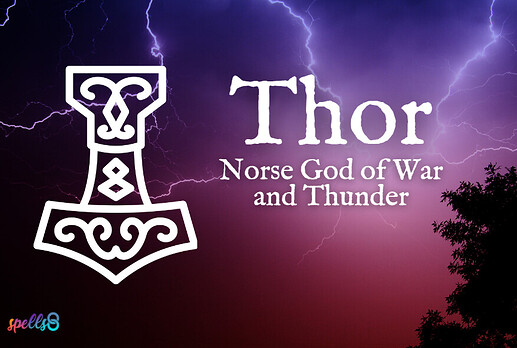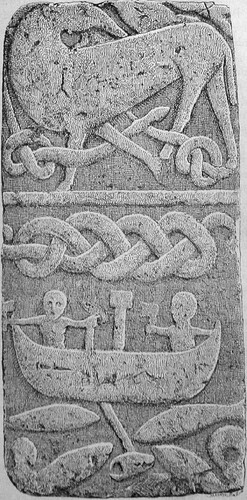An ever-popular deity in Norse mythology and popular culture, Thor is the Norse God of War and Thunder. There is so much more to him than thunder, war, and Marvel, though. Today, we are going to explore Thor, his mythology, and why you might find working with him helpful!
Who is Thor?
We can begin with his name. In the old Germanic language, Thor’s name was the word for thunder ![]() and thus begins his association with thunder and the lightning bolt! It is said in some traditions that he is the son of Odin, though this is not true for all traditions and stories. Some even say that in ancient times, he was more worshiped than Odin himself.
and thus begins his association with thunder and the lightning bolt! It is said in some traditions that he is the son of Odin, though this is not true for all traditions and stories. Some even say that in ancient times, he was more worshiped than Odin himself.
According to Britannica Encyclopedia, Thor is said to be a great warrior of middle-age with a red beard and enormous strength. We can see his strength represented throughout his stories, but we will get there soon. Besides being associated with thunder, he is also most known for carrying around his hammer, Mjollnir. This hammer was forged by dwarves and never failed Thor as his weapon.
Thor is married to the fertility goddess Sif and has three children. Two children - a son named Moda and a daughter named Thrud - are from Sif. The third child, a son named Magni, is potentially from a relationship with the gientess Jarnsaxa, but we are not quite sure.
Norse mythology states that Thor is the defender of Asgard, realm of the Gods, as well as Midgard, the realm of the humans. In his stories, we see him fighting many beasts, though there are a few battles that always seem to happen more than once. These battles include the fights with Jörmungandr as well as the giants.
Thor’s Known Stories
We are lucky that many of the stories of Norse deities survived from ancient times. These usually come int he form of the Eddas, poetry and prose that details stories of the Gods, their battles, and other major events. It is also said that the roar of thunder was Thor’s chariot racing across the heavens.
Thor functioned primarily as a protector-god, although stories concerning him also explained natural phenomena, thus linking him with the etiological type of myth (one which explains how some aspect of life came to be). He was said to burst forth from his great hall in his chariot, drawn by two male goats – Tanngnjóstr (Tooth Gnasher) and Tanngrísnir (Snarl Tooth) – who could be killed and eaten by the god and then brought back to life the next day as long as their bones remained unbroken. The roar of thunder was the rumble of Thor’s chariot’s wheels across the vault of the heavens and, in another story, he is credited with creating tides. Source
It is difficult to talk about Thor without also talking about Jörmungandr, as they face off in battle many times throughout Norse mythology. I detailed one story before in talking about serpents in mythology. Here is another story of Thor and Jörmungandr. I could not find the original, so this is a retelling from this source written by me.
It is said that after Thor’s failed attempts to win the games the giants gave to him upon entering Utgard-Loki, he became determined to best Jörmungandr. For you see, the giants deceived Thor. They made Jörmungandr appear to be a large cat and challenged Thor to lift him in the hall. However, he was only able to lift one of the cat’s paws. They also challenged Thor to a drinking contest – Thor was known for his drinking – but he was unable to finish the drinking horn he was given. Why? Because he was tricked again! The drinking horn was connected to the ocean. When Thor quit the contest, he had already drank up half the ocean!
With these failures, you can see his determination to best Jörmungandr. With that, Thor set sail with a giant named Hymir to go fishing. He had a special bait that he hoped to capture Jörmungandr with: the head of an ox.
While they waited in the ocean, fishing rods in the water, Thor felt the ocean ripple beneath him and something tugged his fishing line. He quickly snatched the fishing rod up and made an attempt to pull Jörmungandr from the water. He was so angry that he was determined to kill Jörmungandr!
However, the giant Hymir knew of Thor’s anger and was afraid Thor would fulfill the prophecy. For you see, it is said that when Jörmungandr breaks upon the surface of the ocean, Ragnarock will begin. Not wanting to bring about Ragnarock, Hymir cut Thor’s fishing line and let Jörmungandr return to the ocean, never breaking the surface of the sea. Thor’s surprise at Hymir cutting the line quickly turned to anger, but rather than kill or hurt Hymir, he simply kicked him off the boat and went to shore without him.
The Gosforth depiction, one of four stones depicting Thor’s fishing trip
via Wikipedia
Working with Thor
Since Thor is a loyal, fierce warrior, you may feel inspired to call on him in your spellwork or worship him in your paganism. Here are a few things Thor may be able to help you with! Please keep in mind that these are generally Neo-Pagan correspondences and do not always align with Norse reconstruction practices or Heathenry. As always, it is my opinion that you should base your practice around your own research and interactions with the deities you are interested in.
 Call on Thor for:
Call on Thor for:
- courage
- bravery
- strength
- protection
 Associations with Thor:
Associations with Thor:
- heavens
- goats
- the color red
- the element air
- beer or mead
- the oak tree
- hammers
- the run Thurisaz
 Offerings for Thor:
Offerings for Thor:
- beer or mead
- anything red
- your courage and strength
- woodworking (this is my UPG and came to me when writing this post)
- meats (nothing boned or with broken bones)
- onions
And that’s Thor!
This is just the beginning of Thor’s stories. I encourage you to reach out to him, learn more, and explore his associates and stories if you are interested in worshiping or working with him.
Have you ever worked with Thor before? Let me know!
Sources
This is a list of sources that I used as well as ones that I randomly found. Happy reading!







